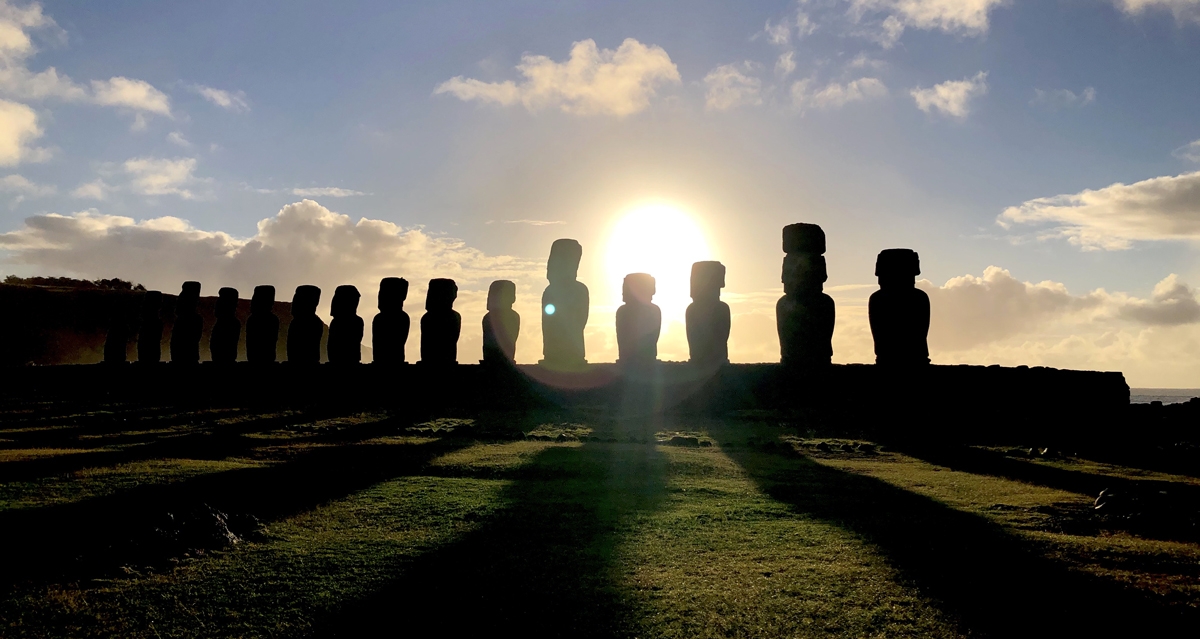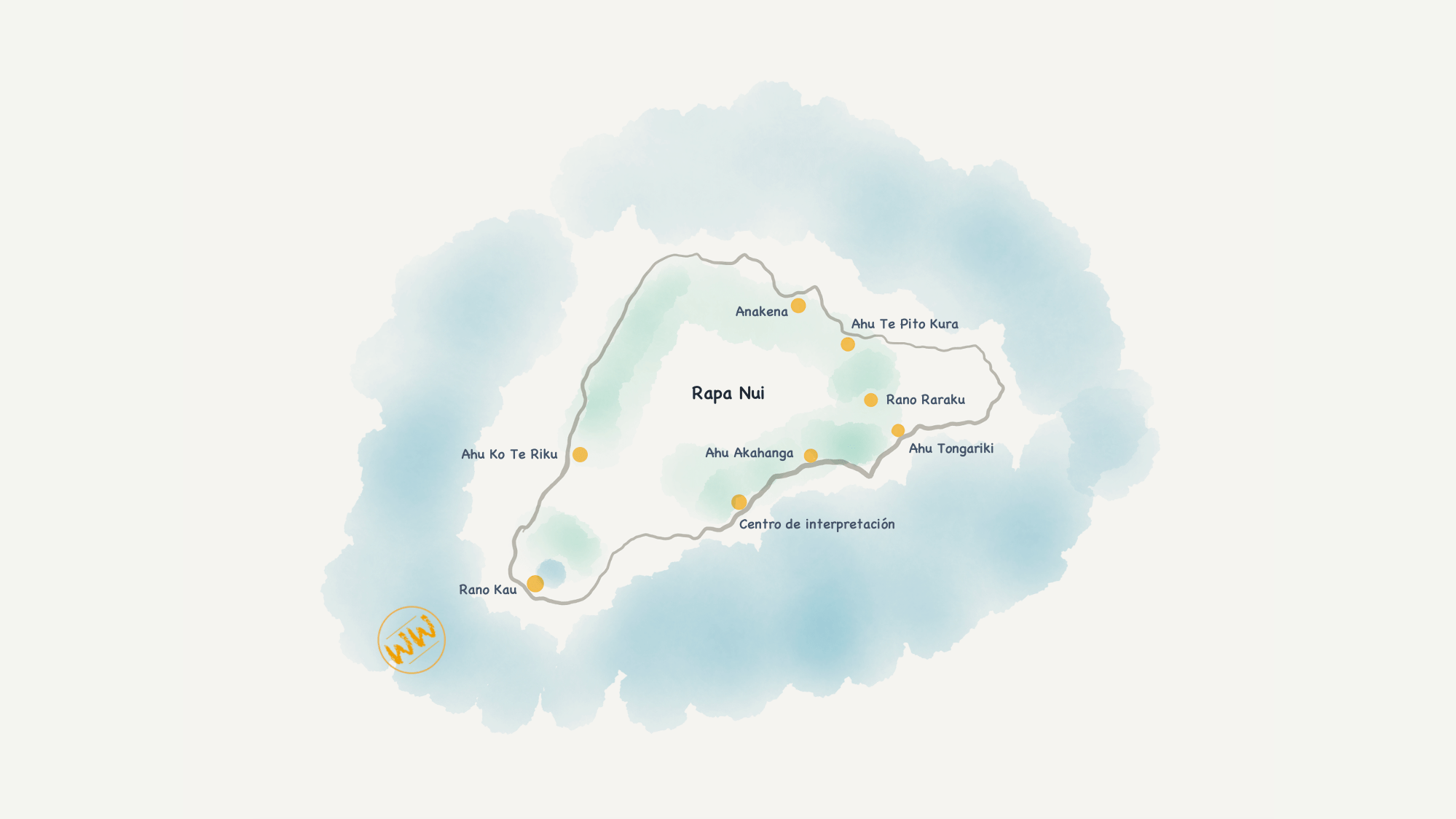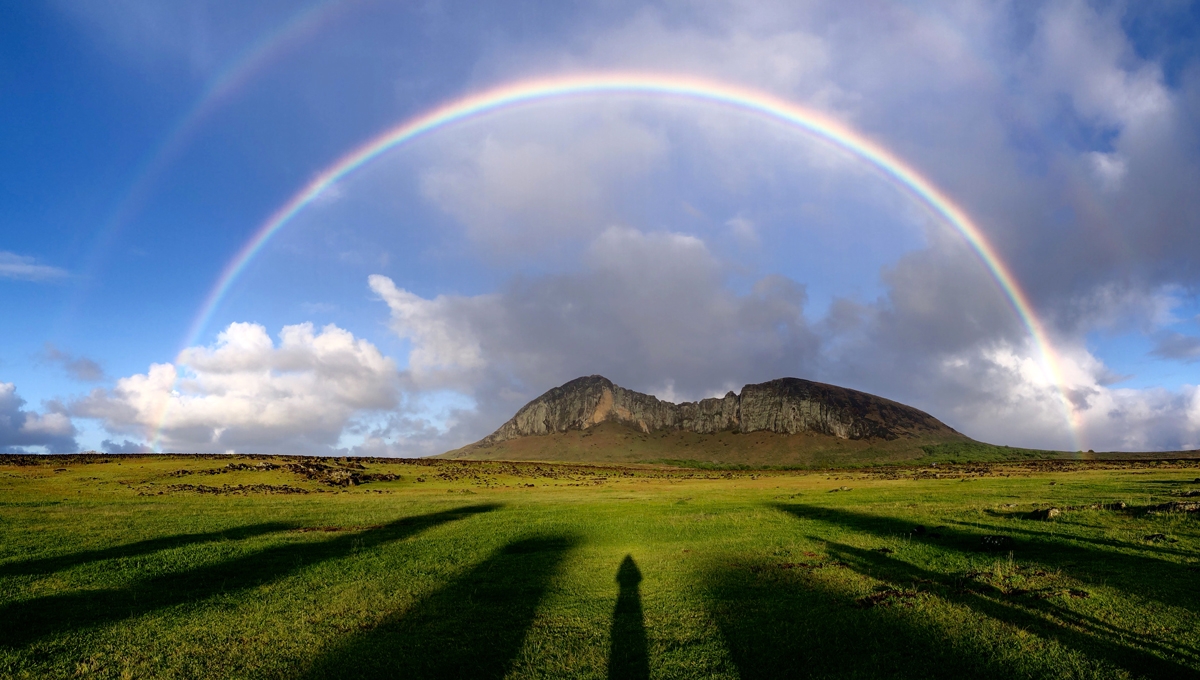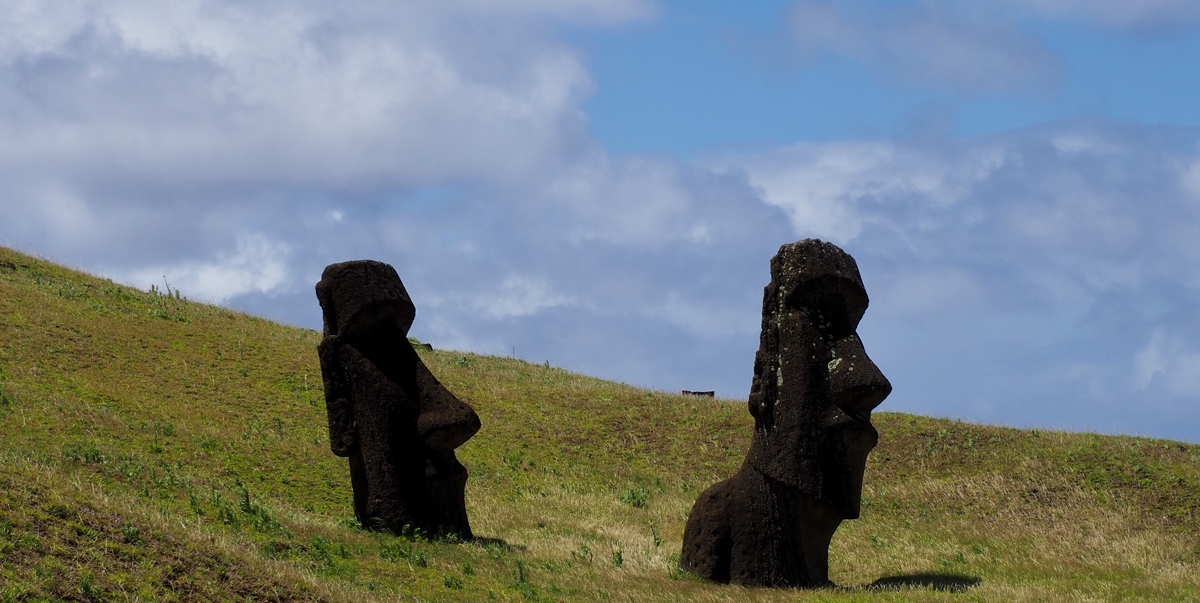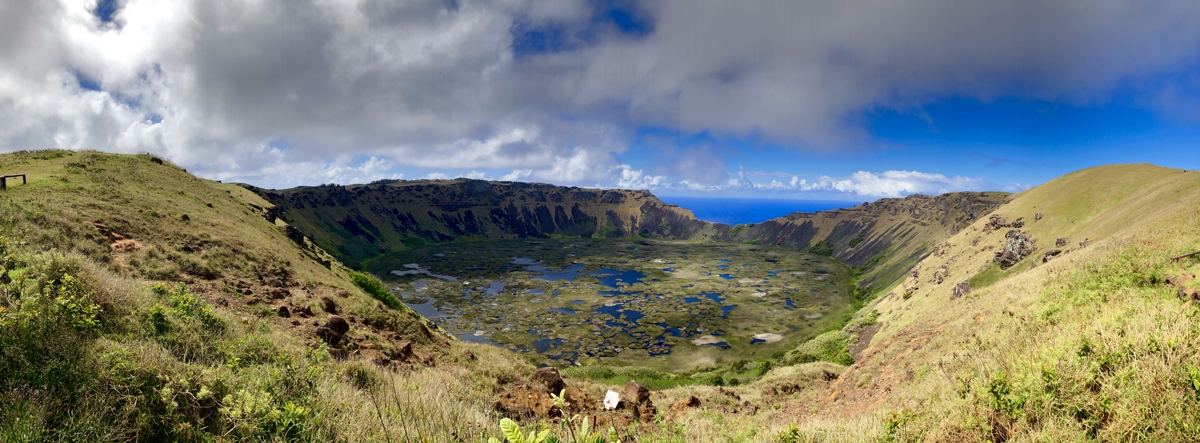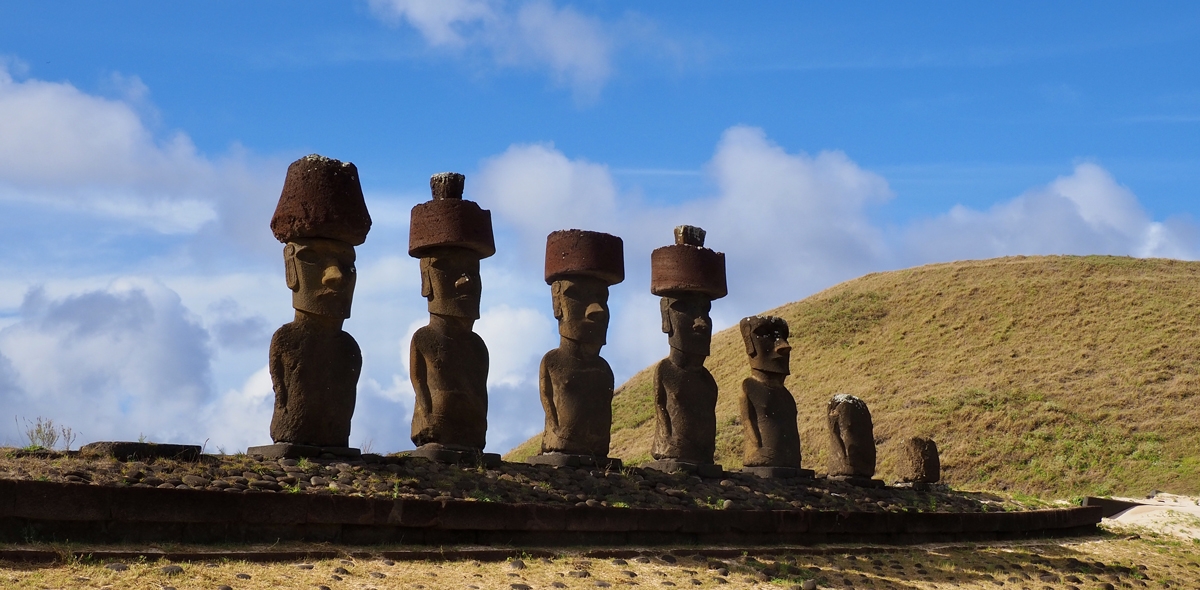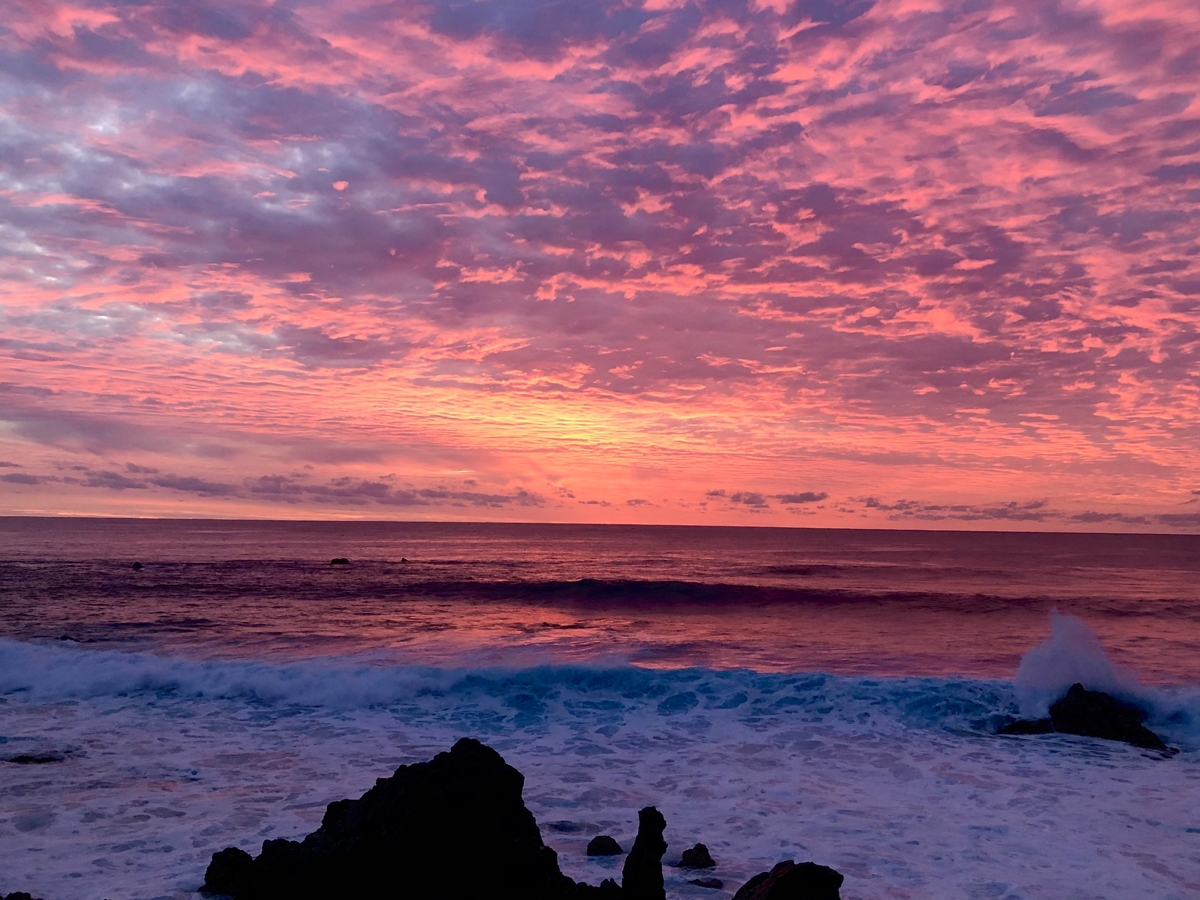Temps de lecture : 10 minutes
Résumé des cinq jours passés sur Rapa Nui, une île chargée d’Histoire perdue au milieu du Pacifique !
Nous sommes heureux de laisser Santiago et son agitation (voir notre article précédent) derrière nous pour nous envoler à 3 500 kilomètres des côtes chiliennes… Direction : Rapa Nui !
Plus connue sous le nom de l’île de Pâques (car elle a été découverte un dimanche de Pâques… original et pertinent, on adore), cette île volcanique ne mesure que 160 kilomètres carrés ! Si elle est majoritairement connue pour les Moaï, ces géants de pierre aussi imposants que mystérieux, Rapa Nui est un condensé de beauté naturelle, un paradis où l’on réapprend à vivre au rythme des éléments.
Nous passerons 5 jours hors du temps à en découvrir chaque recoin pour notre plus grand bonheur…
Quelques infos culturelles
Si on résume l’histoire de l’île…
Au VIIIème ou IXème siècle, des explorateurs polynésiens accostent sur la plage d’Anakena où leur roi Hotu Matu’a décide d’installer un village : le berceau du peuple Rapa Nui. D’autres villages seront par la suite construits en différents points de cette île, dont la pierre volcanique permet de bâtir les infrastructures nécessaires à une vie tournée vers la nature (abris sommaires pour la nuit, poulaillers, infrastructures agricoles…), puis les fameux Moaï, dont les premiers apparaissent dans le courant du XIIIème siècle.
Au XVIIIème siècle, un navigateur néerlandais accoste sur l’île et lui donne le nom d’île de Pâques. Elle sera successivement annexée par l’Espagne, la France, puis le Chili. Au XXème siècle, l’île est louée au Royaume-Uni par le Chili pour y installer des élevages de moutons, transformant profondément sa végétation et cantonnant ses habitants, qui ne sont plus autorisés à circuler librement sur l’île.
A la fin du même siècle, l’UNESCO classe l’île au patrimoine mondial et l’activité touristique du parc naturel se structure. Depuis quelques années, cette activité est opérée par la communauté Rapa Nui qui assure la préservation de son patrimoine naturel, archéologique et culturel.
Un Moaï, qu’est-ce que c’est ?
Les Moaï sont des statues de pierre à l’apparence humaine de taille variable en fonction de l’époque à laquelle ils ont été taillés (de 4 à 12 mètres environ ; le plus grand taillé mesure 21 mètres et n’est jamais sorti de la carrière où il a vu le jour…). Ils sont la représentation des sages disparus du village, détenteurs du Mana : à la fois capacité à rayonner de manière positive et pouvoir de connexion avec les esprits des ancêtres.
Ces statues étaient disposées sur des Ahu, plateformes cérémoniales en pierre. Tournées vers les villages, elles veillaient ainsi sur leur habitants et servaient de canal de communication avec les ancêtres et le dieu Make Make.
Infos pratiques
Comment y arriver ?
Rapa Nui reste relativement préservée du tourisme afin de protéger son patrimoine culturel et naturel. Les moyens de s’y rendre sont donc limités !
Un vol quotidien assuré par LATAM permet de relier Santiago et Hanga Roa, la seule ville de l’île, en 5 heures environ. Un vol hebdomadaire arrive également de Tahiti où il repart aussitôt… Et c’est tout !
Depuis 2019, il est indispensable de remplir une déclaration en ligne avant de prendre l’avion : pensez à le faire au moins 48 heures à l’avance pour éviter les problèmes !
Le parc naturel : comment ça marche ?
L’ensemble de l’île est un parc naturel… On achète donc son billet à l’aéroport pour accéder à la totalité des sites (54 000 CLP par personne, payable en liquide exclusivement ; gratuit pour les PMR, mais n’hésitez pas à signaler votre situation de manière explicite pour faire valoir vos droits : une fois le billet acheté, pas de remboursement possible !). Il est également possible de se procurer son ticket au bureau d’information touristique situé dans le centre-ville.
Une fois votre ticket acheté, ne le perdez pas ! Il sera tamponné à l’entrée de chaque site : pas de ticket, pas d’entrée !
A noter par ailleurs que dans un souci de préservation, deux sites ne peuvent être visités qu’une seule fois (vous ne serez pas autorisés à y entrer à nouveau si votre ticket a déjà été tamponné) :
- Rano Raraku, la carrière de Moaï et son volcan,
- Le site d’Orongo et ses vestiges, sur le volcan Rano Kau.
Combien de temps rester ?
Beaucoup de visiteurs font l’aller / retour pour deux à trois jours… Ca nous semble un peu court ! Bien sûr, on peut visiter tous les sites en trois jours… Mais malgré (ou du fait de) la taille de l’île, les lumières et les couleurs sont changeantes d’une heure à l’autre ! Pour profiter pleinement des paysages, il est donc bon de pouvoir revenir sur vos sites préférés différents jours à différentes heures… Et donc de passer plus de temps sur place !
Pour nous, 5 à 7 jours sont idéaux pour explorer l’ensemble des sites, passer un peu de temps sur la plage de l’île et en profiter pour faire une promenade à cheval par exemple… Si vous avez tendance à avoir des fourmis dans les jambes, optez plutôt pour 5 : il suffit de 30 minutes environ pour traverser l’île du Nord au Sud, on fait vite le tour !
La durée maximale de séjour autorisée sur l’île est de 30 jours pour les touristes.
Où dormir ?
Les hébergements ne manquent pas à Rapa Nui, du camping aux hôtels confortables. La majorité de l’île étant protégée, ils se concentrent principalement autour d’Hanga Roa. Nous choisissons de dormir à l’Hostal Tojika, un hostel idéalement situé, au bord de l’eau (côté ouest pour une vue imprenable sur le coucher de soleil) et à deux pas de la ville.
Où manger ?
Nous redécouvrons ici les plaisirs de manger du poisson et des fruits de mer… Garantis frais !
En 5 jours, nous testons différents restaurants (les prix sont globalement équivalents à ce qu’on peut trouver au Chili… Donc en France), voici ceux que nous avons préférés :
- Anakena Hopu, pour ses délicieux plats traditionnels et ses jus de fruits frais à déguster à l’ombre des palmiers,
- Tataku Vave, pour ses poissons grillés et un déjeuner en terrasse, les pieds dans l’eau,
- Te Moai Sunset, pour ses excellents cocktails que l’on sirote au coucher du soleil…
Où acheter des souvenirs ?
Une catégorie qu’on n’a pas tellement l’habitude de faire apparaître dans nos articles… Mais l’expérience est suffisamment atypique pour être notée, puisque nous achetons quelques souvenirs de l’île… En prison !
Le centre pénitentiaire de l’île (situé dans Hanga Roa à l’angle de Manukena et Mataveri) prône la réinsertion par le travail et propose aux détenus de produire et de vendre de l’artisanat local (bijoux, statuettes en bois ou en pierre…). Des objets faits à la main, bien moins chers que ceux que vous trouverez dans les boutiques du centre-ville (ouverture au public tous les jours de 9h30 à 13h et de 15h à 17h30) !
Pourquoi visiter l’île hors saison ?
On vous l’a dit, une grande partie de charme de l’île réside dans la lumière et les couleurs, changeantes en fonction des moments. Aller à Rapa Nui au début du printemps (octobre – novembre), c’est s’exposer à des averses nombreuses… Mais passagères ! Une fois la pluie passée, la lumière sous les nuages et les arcs en ciel omniprésents (on n’en a jamais vu autant en si peu de temps) finissent de nous convaincre que le moment est idéal… Une raison de plus de passer quelques jours sur place : si la météo vous réserve de mauvaises surprises, le mauvais temps ne s’attarde jamais longtemps sur l’île : vous êtes donc à peu près sûr de pouvoir en profiter si vous restez plus de deux jours…
La période est également moins prisée des touristes : vous aurez donc l’occasion de vous promener dans les sites plus sereinement qu’en plein cœur de l’été !
On recommande
1. Prendre une journée pour visiter l’île avec un guide
La culture Rapa Nui est passionnante et les sites ne donnent que peu (voire pas en fonction des endroits) d’informations sur l’histoire de l’île, de son peuple et de son patrimoine architectural. Visiter l’île avec un guide local a donc une vraie valeur ajoutée !
En une journée (9h30-17h ; 50 000 CLP par personne), nous découvrons l’histoire de l’île et en explorons les principaux sites :
- Le Centro de Interpretacion, un village Rapa Nui reconstitué sur ses ruines, qui permet de comprendre le fonctionnement de leur société et de leurs infrastructures,
- L’Ahu Akahanga, ses Moaï couchés et sa grotte,
- Rano Raraku, la carrière où étaient taillés les Moaï,
- L’Ahu Tongariki et ses 15 Moaï debout,
- L’Ahu Te Pito Kura, où l’on observe le plus grand Moaï jamais érigé sur un Ahu (maintenant tombé) et la « pierre magnétique »
- La Plage d’Anakena, plage de sable blanc entourée de palmiers où s’installa le premier village Rapa Nui.
eee
Cette première visite vous permet également d’identifier les sites que vous préférez et dans lesquels vous aimeriez repasser et quand en fonction de leur exposition…
Le site Tours by Locals propose différents parcours.
2. Se lever du bon pied à l’Ahu Tongariki
On a rarement vu quelque chose d’aussi beau qu’un lever de soleil sur ces quinze colosses de pierre… A couper le souffle ! L’endroit est connu, on vous conseille donc d’y arriver tôt pour être bien positionné… Et de ne pas partir trop tôt ! Même si le ciel est nuageux, le mauvais temps peut vite passer et vous réserver de belles surprises (pour nous, une lumière exceptionnelle et inespérée alors que la plupart des personnes présentes avaient déjà baissé les bras… Et un double arc-en-ciel dans la lumière rasante, rien que ça) !
3. Admirer le soleil se coucher sur l’Ahu Ko Te Riku
Là encore, le spot est bien connu des touristes. Assis dans l’herbe pour profiter également de l’Ahu Tahai ou en sirotant un cocktail au Te Moai Sunset, ne passez pas à côté de ce moment incroyable malgré la fréquentation ! Les couchers de soleil depuis le bord de l’eau à ouest de l’île (sans forcément avoir de Moaï sous les yeux) ou depuis le volcan Rano Kau valent également le détour…
4. Se promener sur les bords du Rano Kau
Ce volcan situé à l’extrémité Sud Ouest de l’île a la particularité d’avoir un cratère recouvert d’une multitude de petits lacs. On y accède par un premier point de vue avant de parvenir au site d’Orongo, un centre cérémoniel dont on visite les ruines restaurées en profitant d’une vue panoramique sur l’île et ses environs.
5. Découvrir les chants et danses traditionnels de Rapa Nui
On a souvent des doutes sur l’authenticité des spectacles folkloriques… Mais on s’est finalement laissé convaincre par le ballet culturel Kari Kari qui propose un spectacle de chants et danses traditionnels à la fois émouvant et plein d’énergie. Précédé d’un film d’une trentaine de minutes racontant la culture Rapa Nui, les spectacles de danse ont lieu les mardis, jeudis et samedis soir (30 000 CLP par personne) et peuvent être suivis d’un dîner si vous le souhaitez.
Il est recommandé de réserver en avance (même hors saison) pour être sûr d’avoir une place : n’hésitez pas à demander à votre hôtel de les appeler.
En fauteuil
Ile volcanique et site naturel préservé, Rapa Nui n’est globalement pas très accessible en fauteuil au sens strict… Ce qui n’empêche pas certaines portions de sites d’être praticables ! On vous recommande quoi qu’il en soit de disposer d’une troisième roue et éventuellement de pneus cross, ainsi que d’un peu d’aide dans certaines pentes…
Voici nos constats par site :
- Centro de Interpretacion (village reconstitué) : le parking est en terre dure et le site est relativement plat, il est donc plutôt simple d’y accéder et de le visiter malgré le sol herbeux,
- Ahu Akahanga (moaïs couchés et grotte) : parking en terre dure mais site à flanc de colline descendant vers la mer. Les chemins en pierre et la pente requièrent un peu d’aide et la grotte en contrebas est très difficilement accessible de près (nous avons renoncé, le sol était trop mouillé et la pente trop raide : on a cependant pu l’observer de loin),
- Rano Raraku : les chemins sont bien aménagés pour se promener entre les Moaï (terre battue), le site est donc très praticable mais longe la colline sur son flanc… Il y a donc un peu de dénivelé. La promenade menant au volcan est très raide : les escaliers ne permettent pas l’accès en fauteuil,
- Ahu Tongariki (15 Moaï) : l’entrée du site dispose d’un chemin aménagé pour les personnes en fauteuil. Assez raide, il permet néanmoins d’accéder aux Moaï. Le reste du terrain est recouvert d’herbe mais on peut profiter du site quasiment à 100% sans problème (sauf le chemin permettant de passer derrière les Moaï, rempli de rochers),
- Ahu Te Pito Kura (pierre magnétique) : le site n’est pas accessible par l’entrée traditionnelle, trop étroite entre deux murs de pierre. Sur autorisation spécifique des gardes à l’entrée, vous pouvez éventuellement y accéder un peu plus loin en voiture, mais à part les paysages magnifiques vous ne verrez pas grand chose : le Moaï couché et la pierre magnétique se trouvent en bas d’une colline rocheuse,
- Ahu Ko Te Riku et Ahu Tahai (coucher du soleil) : le site est accessible depuis l’entrée Nord (au pied du restaurant Te Moai Sunset). Relativement plat, il est praticable facilement malgré l’herbe,
- Anakena (plage) : des rampes en bois permettent d’accéder aux deux entrées de la plage (haute et basse) pour avoir une vue sur l’Ahu Nau Nau et l’Ahu Ature Huki. Elles s’arrêtent en revanche un peu tôt : l’accès à la plage se fait par le sable et les rochers… Le grand terrain herbeux autour des Ahus est néanmoins praticable malgré des pentes conséquentes autour de la plage. Des toilettes accessibles sont disponibles à l’entrée haute de la plage,
- Rano Kau et Orongo (volcan et site cérémonial) : l’accès se fait en voiture jusqu’au premier point de vue (équipé d’une rampe), puis jusqu’au site d’Orongo. L’exploration du site cérémoniel est presque intégralement accessible (toilettes comprises) à l’aide d’un fauteuil cross mis à disposition gratuitement à l’entrée. Un Guarda Parque est par ailleurs à votre disposition pour vous accompagner (les pentes sont raides). La visite s’arrête au pied des escaliers qui ramènent au centre des visiteurs (environ 80% du site est donc accessible), il faut ensuite faire demi-tour,
- Centre pénitentiaire (souvenirs) : non accessible (entrée fermée par des tourniquets étroits).
Dans notre prochain article
Nous terminons notre séjour ressourcés, physiquement et mentalement. Nous survolons une dernière fois cette île pour laquelle nous avons eu un coup de cœur difficilement descriptible et la regardons disparaître peu à peu par le hublot, la gorge légèrement serrée. Une chose est certaine : on ne sort pas de ce séjour complètement inchangés ! Le calme qui émane de cette île et de ses habitants et la beauté brute de la nature encore (ou à nouveau) préservée dégagent une harmonie qui nous touche.
Nous rentrons à Santiago sous couvre-feu pour la nuit avant de repartir pour notre prochaine destination : la Patagonie !

